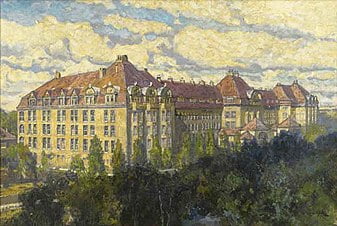The National Institute for Deaf-Mutes in Paris, France, stands as a pivotal institution in the history of Deaf education, recognized as the first school for the Deaf in the world. Its founding, evolution, and impact on Deaf education reverberate through history, shaping the way society perceives and educates Deaf individuals.
The Foundation of the Institute
Established in 1760 by Charles-Michel de l’Épée, commonly known as Abbé de l’Épée, the National Institute for Deaf-Mutes, or the “Institut National de Jeunes Sourds de Paris” in French, was born out of a profound commitment to educating Deaf children. Abbé de l’Épée was inspired by the story of two Deaf sisters communicating through signs and gestures, leading him to develop a manual sign language system known as Old French Sign Language.
The Institute pioneered a formal system of education for the Deaf, providing not only academic instruction but also fostering communication, socialization, and vocational skills among Deaf individuals.
Abbé de l’Épée’s Impact
Abbé de l’Épée’s methods of instruction centered on sign language as the primary mode of communication for Deaf students. He believed in the innate intelligence of Deaf individuals and advocated for their right to education, challenging prevailing misconceptions about the intellectual abilities of the Deaf.
His legacy lies not only in establishing the Institute but also in promoting sign language as a legitimate means of communication, leading to the recognition and validation of sign languages worldwide.
Evolution and Contributions
Over the years, the Institute expanded its reach, welcoming students from various backgrounds and regions. It became a hub for exchanging ideas, fostering educational innovations, and training teachers in specialized methods of educating Deaf students.
Notably, the Institute’s impact extended beyond France. Educators and reformers from different countries visited the Institute to study Abbé de l’Épée’s methods, inspiring the establishment of similar schools for the Deaf worldwide.
Legacy and Modern-Day Presence
The Institute’s rich history and contributions laid the foundation for Deaf education globally. Despite changes in educational approaches and advancements in technology, the Institute remains a symbol of dedication to Deaf education and the recognition of sign language as a crucial aspect of Deaf culture and communication.
Today, the legacy of the National Institute for Deaf-Mutes lives on in various ways. While the original Institute is no longer operational, its impact continues through modern institutions dedicated to Deaf education, advocacy, and preserving sign languages.
Conclusion
The National Institute for Deaf-Mutes in Paris holds a prominent place in history as the pioneering institution for Deaf education worldwide. Abbé de l’Épée’s dedication to the education and empowerment of Deaf individuals, his advocacy for sign language, and the Institute’s legacy as a center for educational innovation reverberate through time, inspiring ongoing efforts in Deaf education and advocacy for linguistic and cultural rights of the Deaf community globally.
Though the original Institute has transformed or given way to modern educational approaches, its foundational principles and impact persist, fostering a legacy that continues to shape the landscape of Deaf education and the recognition of sign languages as vital means of communication.



